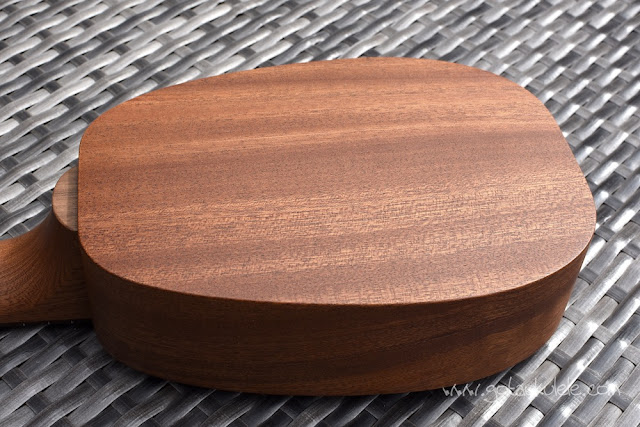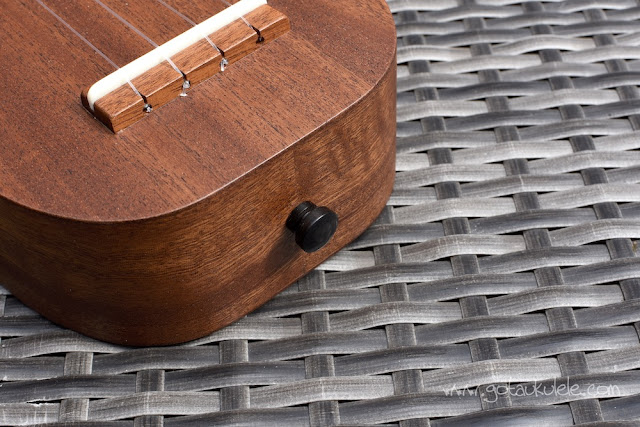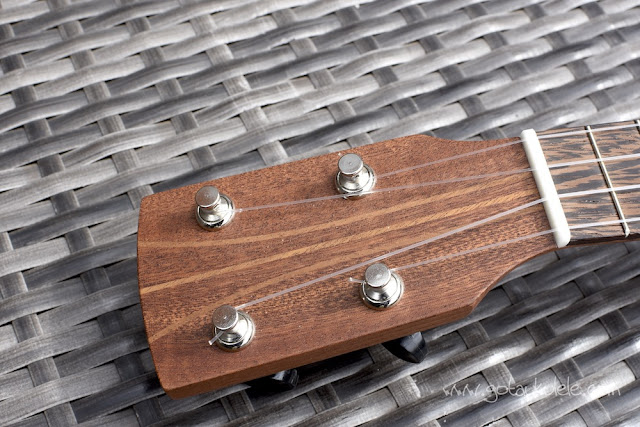It was back in 2015 when I first looked at a musical instrument from the UK luthier DJ Morgan (Dave Morgan) when I was given chance to look at one of his soprano ukes. That one was very nice so I'm delighted to be able to feature him again with a look at the interesting 'mini pineapple' ukuleles he has been is building recently.
The idea for them came about when Dave made a few of these for sale on his stall at the 2015 Ukulele Festival of Great Britain in Cheltenham. They did very well, so he made some for recent festivals and has now decided to make more batches that will be available through his site. But what are they exactly?
Well if you follow the world of ukuleles, you can't have avoided the recent surge in the very small models. That is to say, ukuleles smaller than sopranos. We have sopraninos from the main brands like Kala and Ohana, we have iUkes, Pixies from John Daniel and Nano's from Andy Miles. So it must have seemed clear to Dave that there would be interest in a smaller version of one of his instruments too. But this one isn't just small - it's a bit different in a couple of other ways too.
First up, apart from the iUke, I haven't seen another mini pineapple / boat paddle shaped ukulele (please correct me if I am wrong), and I've certainly never seen any mini ukulele that use the sound hole design this one has. We'll come on to more about that in a moment, but it did leave Dave with some head scratching I think.
So it's a very attractive boat paddle / pineapple shape that I love, and I suspect that may be no bad thing on a smaller instrument. You see the smaller the body, the less resonance there is, yet pineapples are renowned to have a 'fuller' tone to similarly scaled double bout instruments. Basically, removing that 'waist' from the shape seems to fill the sound out. Incidentally, when I say these models of his are 'smaller', this is not the smallest instrument out there, but it is smaller than a regular soprano. The scale length of this is actually at 11 and ⅝ inches which is about 2 inches shorter than his standard soprano ukuleles These are made from all solid tone woods, and Dave is going to be making them in a variety of wood combinations that are all of the same price. This particular one is made from Meranti, but at the end of this review is a picture of a model made from Acacia.
First up it's extremely well put together with exact and accurate joints at every turn and no issues I can spot. It really does feel very high quality. And there is just something about that soundhole design that sets it off. Firstly we have an off centre soundhole on the top, but to give more sound to the player, Dave has added a side sound port on the top shoulder, something I know that many people love. Dave explains that being a small instrument it was probably never going to have a loud voice as an ensemble instrument, so he went with the side port to ensure that the sound to the player was as clear as it can be. A nice idea, but I will touch on the sound a little later.
The top and back are single pieces, but the sides on this are in a pair.
And the challenge that then created was how to attach the body to the neck. You see Dave uses a bolt on neck design that with a standard ukulele would involve putting the appropriate wrench in through the sound hole to tighten it. It's a common build technique used by many luthiers, but as we have an off centre sound hole that wasn't physically possible. The answer he hit upon was to drill a hole in the base and go through that way. And what do you do with a hole in a ukulele? Well, it's perfect to house an old style push in strap pin. Neat! The pin is turned from wood and I think looks great. Thoughtfully Dave has made it removeable (you can literally pull it out) for those people who get apoplectic about strap buttons on ukuleles. If you like it (and I do) a dab of titebond on it will ensure that it is going nowhere.
Bridge wise we have a mahogany slotted style fitted with a compensated corian nut. It's extremely nicely carved with slots that differ in thickness depending on the string they are taking. Nice.
One of the other nice things about side sound ports, at least to a ukulele reviewer like me is that they make it really easy to look inside the body. On some instruments that has sadly shown off a multitude of sins in terms of messy construction, but I am pleased to say that on this one it shows off some excellent luthiery. Really neat and tidy, delicate braces, notched kerfing and absolutely no mess. We have the makers logo off to the centre also so you can see it through the sound hole. There is a single cross back brace and because there is no central sound hole, there is no cross brace on the top, rather a single fan brace running down the middle, top to bottom.
There is no other decoration and the body is finished in a matt cellulose lacquer coating which feels nice on the fingers.
Up to the neck and this is made of a single piece of Sapele machined by Dave to shape. It's got a really nice profile to it and with a similar finish is extremely smooth under the hands. The fingerboard on this is topped with Wenge which is just stunning I think. The stripe really gives it a nice look that you don't often see on fingerboards. Fitted to this are 12 nickel silver frets down to the body joint, all nicely dressed and finished. We have inlaid dot markers on the face at the 5th, 7th and 10th spaces and thankfully these are repeated on the side. Incidentally, that nut is about 35 mm across.
Beyond the Corian nut we have a plain shaped headstock decorated with what I think is now the DJ Morgan design of inlaid wooden fan strips. I really like it. I liked the style on the soprano I reviewed, but thought it was a little too stark in black. These are subtle and give it a certain something.
Tuning wise, these are unbranded friction pegs, but I can attest that they work brilliantly with no stickiness and hold well without masses of tension. It would have been a total disaster to put big ears on a small little ukulele like this one.
We have a set of fluorocarbon strings which are Seaguar Blue Label fishing lines, and Dave has used the same gauge he fits to sorpanos as this is designed to be tuned to regular C tuning. And as for the price, well that's a pretty terrific £185 in whatever wood spec he makes them in. All will be the same, and that is an extremely good deal I think for an all solid wood luthier built instrument. Amazing in fact.
In the hands it's a delight, and extremely light too. Naturally, it's balanced as well and really easy and fun to hold. There is no grappling with this to get yourself comfortable. Set up is spot on, as you would expect from a luthier.
And as for the sound. Well, as I said above, Dave had explained that the side port was to compensate for it not being a loud instrument. Well... ok, it's not got the punch of some of the loudest sopranos out there I have played, but this is no slouch. I really want to make that clear. This is NOT an overly quiet instrument at all. In fact, this will stand up perfectly well to many, many other sopranos I have played. It also punches much bigger than most other sopraninos I have played.
And it's a really pleasnt tone too, as you would expect from a luthier build. Tons of character and pretty great sustain. Naturally, being a small instrument the staccato sound of a strum is a real joy to listen to (like good sopranos), but I also enjoyed noodling with this one fingerpicked too. Of course, setup was spot on with this and that means intonation was remarkably good up the neck.
Now I'm not getting ahead of myself here. Sub soprano ukuleles are not truly serious I suppose. You are not getting into one of these as a performance instrument (although one or two people have made a great fist at that on big stages in cetain numbers), they are more (dare I say it) novelty or talking poonts. But then perhaps the appeal for travel, or just for when you want something smaller is there too. As such it would be wrong to compare this to bigger ukuleles, so perhaps my scoring system is flawed. But for what it is, I think it's utterly delightful.
So I have been totally and utterly taken with these whilst I have had them on loan. I own one other sub soprano ukulele in the form of the John Daniel Pixie, but nothing else that has yet come along has really made me say, YES I need another. I fear that may have just happened here.
Absolutely superb.
http://djmorganukuleles.co.uk
UKULELE PROS
Sublime build
Great tone, sustain, setup, everything really!
Wonderful fingerboard
Great price
UKULELE CONS
Absolutely nothing I can think of
UKULELE SCORES
Looks - 9 out of 10
Fit and finish 9.5 out of 10
Sound - 9 out of 10
Value for money - 9.5 out of 10
OVERALL UKULELE SCORE - 9.3 out of 10
UKULELE VIDEO REVIEW
© Barry Maz
WHY NOT DONATE TO HELP KEEP GOT A UKULELE GOING?

THANKS!










I love that you love it! As a novice player I bought one on impulse from Dave at Cheltenham and am very pleased with it 😎
ReplyDeleteSeriously - what's NOT to love?
ReplyDeleteIndeed
ReplyDeleteA left handed version would be nice.
ReplyDeleteI believe he is going to make a left hander in each batch of 10 he makes Keith
ReplyDeleteAnother top class review for Dave Morgan. This just reinforces my long held view that his workmanship and attention to detail is second to none. Thanks for bigging him up Barry.
ReplyDeleteI have one in purple heart which is unbelievably loud for its size and holds its own on club nights. Other members have been disappointed when I didn't take it! Highly recommended.
ReplyDeleteThrilled to see this fantastic review for Dave's work; I have been a firm fan of the quality and pure classiness of his ukes for more than two years and now have four, including the very first mini-pineapple! Just brilliant and a well-deserved review! So pleased!
ReplyDeleteAww thanks Lesley! Yes, he's a terrific luthier I think.
ReplyDeleteCan't help but notice the involuntary smile you have whenever you review a uke you really love....This uke looks and sounds supreme (with a good price point)!
ReplyDeleteI bought a Padauk mini on this recommendation - have been very pleased with my little darling! Thanks, Baz.
ReplyDelete